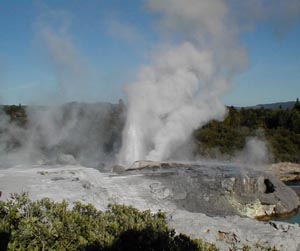
Geyser
"Thar she blows!"
Introduction
Geysers can be spectacular spewing steam and hot water hundreds of feet into the air. They are essentially geothermally powered percolators.
Material
Assembly
Fill the flask with water.
insert the stopper into the flask
drill a hole in the bottom center of the plastic bowl, insert the glass tube into the hole The end of the tube should be flush with the inside surface of the bowl or protrude only a short distance into the bowl. Hot melt glue the bowl to the glass tube,(You may also glue it with Goop or silicone seal.)
Insert the glass tube into the stopper
Support the glass tube and flask over the heater with the ring stand.
Fill the glass tube to the top with water, add water until there is a 1/2 m deep layer in the bowl.
wear eye protection
To Do and Notice
Bring the water to a boil in the flask. Notice that it erupts out of the tube making a small geyser. After the first eruption the flask will refill itself from the water in the bowl time how long it takes until the next eruption. If the flask does not refill itself add enough water to the bowl until it does.
What's Going On?
The water in the flask and tube is heated from below becoming hot at the bottom and cooler at the top. This is the same thing that happens in a natural geyser. The water heats slowly. As the water heats it expands and flows out of the top of the tube. Even though the tube remains full of water, the water in the tube is less dense and so the pressure at the bottom of the geyser decreases.
The boiling point of water is a function of pressure. As the pressure decreases the boiling point also decreases. At some point the pressure decreases so that boiling occurs inside the geyser, this pushes more water out of the tube replacing it with water vapor and further decreases the pressure, this is an example of positive feedback. The lessened pressure causes the entire flask and column of water to start to boil creating a geyser. Notice that even though the change from liquid to gas removes energy from the liquid, cooling it off, the reduction in pressure is so great that the cooler liquid remains above the boiling point, so that the eruption can continue. Eventually, enough liquid water is converted to gas to reduce the temperature of the water to below the boiling point, the eruption stops. Cold water from the basin then drains into the flask preparing it for the next eruption.
Etc
The energy source for natural geysers is magma, molten rock, below the ground. Some geysers erupt at regular intervals, e.g. "Old Faithful" before a recent set of earthquakes. Others erupt with chaotic time scales.
|
Scientific Explorations with Paul Doherty |
|
27 June 2006 |